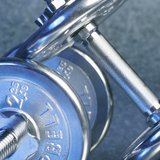Where Optimal Health Is The End Result!
Banana!
Fri, Apr 21, 2017
at 1:00AM
The Peel: Thanks to its oil, rubbing the inside of a banana peel on a mosquito bite (or other bug bite) or on poison ivy will help keep it from itching and getting inflamed.
Bananas float in water, as do apples and watermelons.
Hawaii is the only place in the U.S. where bananas are grown commercially, although at one time they were also grown in southern California and Florida. The overwhelming majority of the bananas Americans eat come from countries in Latin America and South America, including Costa Rica, Ecuador, Colombia, Honduras, Panama, and Guatemala.
The type of banana you see in the supermarket is called a Cavendish banana. The preferred variety was originally the Gros Michel, which essentially became extinct by 1960, thanks to a fungus called Panama disease.
Americans eat an average of 27 pounds of bananas per person every year.
A man in India once ate 81 bananas in a half hour.
Bananas don’t actually grow on trees—they grow on plants that are officially classified as an herb (not surprisingly, the world’s largest herb). They’re in the same family as lilies, orchids, and palms.
A cluster of bananas is called a hand, and a single banana is called a finger. Each banana hand has about 10 to 20 fingers.
Bananas have been depicted in ancient Egyptian hieroglyphs.
Bananas are the only fruit that contains the amino acid tryptophan plus vitamin B6. They help your body produce serotonin—a natural substance that alleviates depression.
About half of all people who are allergic to latex are often also allergic to bananas.
Research shows that eating bananas may lower the risk of heart attacks and strokes, as well as decrease the risk of getting some cancers.
Bananas are low in calories and have no fat, no sodium, and no cholesterol. They contain vitamin C, potassium, fiber, and vitamin B6.
If you peel a banana from the bottom up (holding on to the stem like a handle), you will avoid the stringy bits that cling to the fruit inside.
If you put a banana in the refrigerator, the peel will turn dark brown or black, but it won’t affect the fruit inside.

Bookmark & Share
User Comments
Be the first to comment on this post below!
Previous Article
Next Article
Most Popular Articles
- Kim's Weight Loss Journey with Integrity Health Coaching Fitness Centers & Gyms in NH
- New Year's - The 12 Months of Christmas!
- Your Scale, Throw It Out.
- Get Blown Away!
- KARINA'S CREAMY DETOX SOUP RECIPE WITH COCONUT MILK
- Store Special April 2 - 7
- Almond Encrusted Chicken
- Maple Avocado Coconut Smoothie
About Integrity
Integrity Health is a franchise company residing in New Hampshire. We specialize in health coaching centers combining fitness with weight loss to optimize and promote optimal health. We are also the national purveyors of the RAMP Metabolic Fitness Prescription licensed by fitness professionals.
We are proud to carry NOW Foods and Supplements at all of our health coaching locations. Get health, stay healthy! GMP Certified for quality assurance!
Follow us!
HEALTH COACHING LOCATIONS

Integrity Fitness & Health Coaching Center 24 Hour Access
491 Main Street
Gorham, NH 03581
491 Main Street
Gorham, NH 03581
Staffed Hours
M-F
10am-5pm
Phone
603-915-9212
FAX
Email

Integrity Fitness & Health Coaching Center 24 Hour Access
1857 White Mountain Highway
North Conway NH 03860
1857 White Mountain Highway
North Conway NH 03860
Staffed Hours
Mon
9am
5pm
Tues
9am
5pm
Wed
9am
5pm
Thurs
9am
5pm
Fri
9am
5pm
Sat
9am
1pm
Phone
603-730-5572
FAX
Email

EZCOACH Fitness Prescription Systems
Solutions For Fitness Centers
Solutions For Fitness Centers
Staffed Hours
Mon-Fri
9am-6pm
EST
Phone
855-550-2348
FAX
Email

